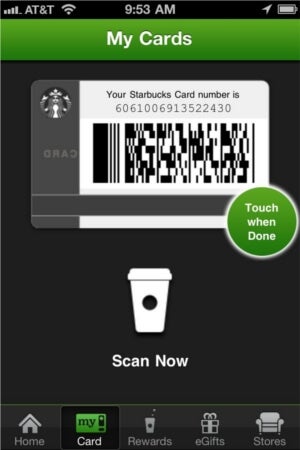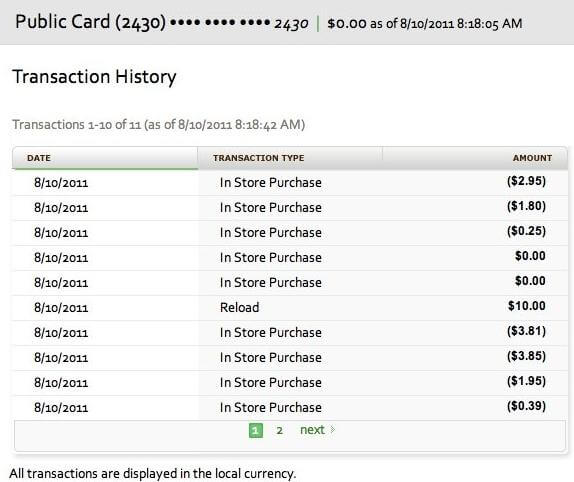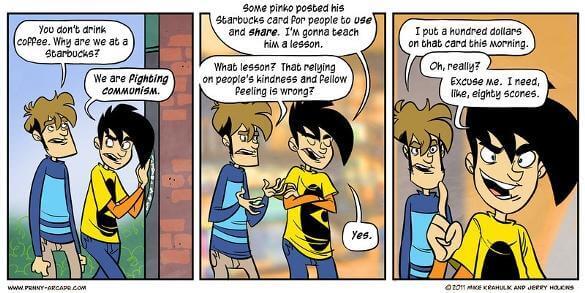The ‘Free Coffee’ Starbucks Card Has Died. What The Social Experiment Really Meant.

Share
The Italians call it "caffe pagato". In the US it's referred to as "pay it forward". 7-11 dubbed it "take-a-penny, leave-a-penny". At Starbucks it was known as "Jonathan's Card"... and it has died. Mobile app developer Jonathan Stark recently decided to help people all over the world buy each other coffee by publicly sharing the barcode for his Starbucks Card. For those unfamiliar with the concept, the Starbucks Card barcode allows you to pay for coffee by simply showing the cashier its image on your smart phone. Jonathan's Card let anyone upload money to the account or use the jpeg of the barcode to pay for their own purchases as they saw fit. Thousands of people took Stark up on his offer, sharing (or borrowing) the wealth at their favorite locations. But on Friday August 12th, roughly five days after it was born, the card died. Starbucks, though reportedly rooting for the idea despite its violations of their user agreement, shut down the account after it was pillaged by hacker(s). Jonathan's Card, an open forum for buying coffee and scones for strangers, didn't last a week. Is the unfettered public sharing of funds simply unsuited to the digital world, or is the Starbucks failure just a bump on the road to a much more charitable future?
For those who didn't read our earlier coverage on the Starbucks Card mobile app, here's a 21 second video on how it works:
Italy's espresso-obsessed culture led parts of the country to adopt the phenomenon known as caffe pagato or "paid coffee". Patrons at an espresso bar purchase their own coffee and then pay for a few extra cups that the barista can dole out later to those who request it. You buy someone else's coffee because you can, because it's nice, and because one day you might be the guy asking the barista if there's any caffe pagato left that day. Jonathan Stark realized a similar trend could easily be developed around the Starbucks Card barcode, as even a jpeg image of the code was enough to purchase goods at any of the 7000 or so franchise locations that took the form of payment. Jonathan's Card was simple in implementation: you went to his website and downloaded the pic to your smart phone (worked fine on both Android and iOS). By checking a dedicated Twitter feed you could see what the approximate balance was on the card and either use it to help pay for your purchase or add more money. You could also donate through a link on Stark's site.
People loved the concept. If you go to the Facebook page, or check out the hash tag on twitter (#jonathanscard) you see almost nothing but praise. As word of the experiment got around on the Internet, traffic on the card picked up, celebrities weighed in, and Starbucks execs started to take notice.
Unfortunately, so did Sam Odio. Odio, not a bad guy, was nevertheless devious enough to devise a way to siphon money off Jonathan's Card and move it to his own. He netted $625 from the (really basic) hack, used it to fuel two gift cards and auctioned those cards on eBay to help a charity. He then shared the information on how to hack the card to everyone who reads his blog. Dishonest? Yes. Evil? No. But it effectively killed Jonathan's Card. Faced with the security breach, Starbucks contacted Stark, told him they were enforcing their user agreement to end the experiment and canceled the barcode at 7pm on Friday August 12th.
As sad as the end of Jonathan's Card may be, the fallout has been illuminating. Another attempt, PayingIt4ward, was launched almost immediately, this time eliminating some of the openness (you have to donate at the counter) in hopes of closing off possible hacks. Hundreds of people say they are now continuing the experiment on their own - paying for coffee and small goods at various stores without using a barcode as an intermediary. Stark continues to tweet about his experiences paying for other people's snacks, and a Google search will find you dozens of others who are either launching variations on the experiment or re-publishing their own experiments which began earlier than Stark's.
Be Part of the Future
Sign up to receive top stories about groundbreaking technologies and visionary thinkers from SingularityHub.


Much of the coverage surrounding Jonathan's Card has followed the same tired old lines of debate: is humanity on the whole more charitable than it is greedy? Will you always have more leachers than donors? Can the internet really be used to better the world?
That discussion bores me, especially as I think the internet has clearly proven itself to be an excellent means of fundraising. The Indian Ocean Tsunami raised hundreds of millions of dollars via the web, US politics is reshaping itself around online donations, and sites like Kickstarter are launching thousands of new ventures by leveraging internet charity.
What I find much more interesting are the lessons Jonathan's Card teaches us about digital exchanges. The card didn't fail because too many people took rather than gave. It didn't fail because of Big Brother style intervention (according to Mashable, Starbucks was rooting for the concept). It failed because security sucked. Plain and simple.
The Starbucks mobile app isn't eBay, it was never designed to be a (charitable) marketplace. Jonathan's Card, however, should show us that there is both a desire and easy path to build such marketplaces. Starbucks could create a single, central, more secure version and launch it. Why not? It would attract customers and build a sense of community that would keep regular users coming back for more. Other retail businesses could do the same whether they are brick and mortar or digital storefronts. I'd gladly round up all my purchases to the next dollar on Amazon if I could put that money into a fund that other Prime customers could use. Pick your favorite store and ask an average customer, and I'm sure you'd find many people with similar sentiments.
Micro-scale charity is just one untapped potential when it comes to digital exchanges. What about people who wish to trade points/currency from various social media sites? There's already a growing market for that in online gaming. Several sites allow you to track/exchange frequent flyer miles, too. Whatever real or virtual goods you can earn, there's someone out there who wants to trade you for them, give you more, ask you to donate, or leverage your combined balance for group gain.
Jonathan's Card is a good indication that such exchanges can work on a person to person level, a corporate sponsored level, or anywhere in between. I think it also hints that such exchanges are going to be a growing part of the online marketplace. Dollars for Yen, or Euros for Yuan - we're used to those currency transactions. But what about points for 'likes' OR World of Warcraft 'gold' for +1 votes OR cash for a sense of community? Those kinds of new transactions are going to become more important parts of the digital market in the 21st Century. Organizing them, making them secure, and attracting users to them is big business. Jonathan's Card wasn't about charity, it was about opportunity. And there's lots of it ready to be seized.
[image credits: Starbucks, Jonathan Stark, Penny Arcade (Krahulik & Holkins)]
[video credit: Starbucks]
[sources: Jonathan Stark]
Related Articles

This Portable Wind Turbine Is the Size of a Water Bottle and Charges Devices in Under an Hour

Mojo Vision’s New Contact Lens Brings Seamless Augmented Reality a Step Closer
The Weird, the Wacky, the Just Plain Cool: Best of CES 2020
What we’re reading


